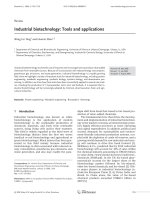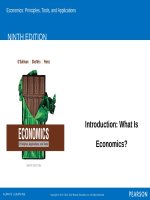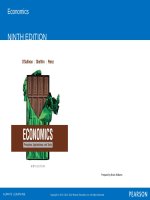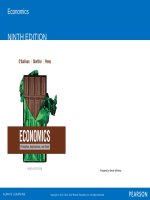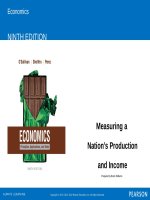Economics principles tools and applications 9th by sullivan sheffrin perez chapter 06
Bạn đang xem bản rút gọn của tài liệu. Xem và tải ngay bản đầy đủ của tài liệu tại đây (1.81 MB, 29 trang )
Economics
NINTH EDITION
Chapter 6
Unemployment
and Inflation
Prepared by Brock Williams
Copyright © 2017, 2015, 2012 Pearson Education, Inc. All Rights Reserved
Learning Objectives
6.1 Define these concepts: the labor force, the labor force participation rate, and the unemployment rate.
6.2 Distinguish between cyclical, structural, and frictional unemployment.
6.3 Describe the costs of unemployment.
6.4 Discuss how the Consumer Price Index is calculated.
6.5 Explain the difference between inflation and the price level.
6.6 Summarize the costs of anticipated and unanticipated inflation.
Copyright © 2017, 2015, 2012 Pearson Education, Inc. All Rights Reserved
6.1 EXAMINING UNEMPLOYMENT (1 of 9)
How Is Unemployment Defined and Measured?
•
The Unemployed:
Individuals who do not currently have a job but are actively looking for work.
Actively looking is critical.
Copyright © 2017, 2015, 2012 Pearson Education, Inc. All Rights Reserved
6.1 EXAMINING UNEMPLOYMENT
How Is Unemployment Defined and Measured?
•
Labor force
The total number of workers, both the employed and the unemployed.
labor force = employed + unemployed
•
Unemployment rate
The percentage of the labor force that is unemployed.
Copyright © 2017, 2015, 2012 Pearson Education, Inc. All Rights Reserved
(2 of 9)
6.1 EXAMINING UNEMPLOYMENT (3 of 9)
How Is Unemployment Defined and Measured?
•
Labor force participation rate
The percentage of the population over 16 years of age that is in the labor force.
Copyright © 2017, 2015, 2012 Pearson Education, Inc. All Rights Reserved
6.1 EXAMINING UNEMPLOYMENT
How Is Unemployment Defined and
Measured?
Approximately 63 percent of the civilian population is in the labor
force. The unemployment rate in January 2015 was 5.7 percent.
SOURCE: Bureau of Labor Statistics, U.S. Department of Labor,
2015.
Copyright © 2017, 2015, 2012 Pearson Education, Inc. All Rights Reserved
(4 of 9)
6.1 EXAMINING UNEMPLOYMENT
How Is Unemployment Defined and Measured?
Among the developed countries, unemployment rates vary substantially.
SOURCE: The Economist , February 14, 2015.
Copyright © 2017, 2015, 2012 Pearson Education, Inc. All Rights Reserved
(5 of 9)
6.1 EXAMINING UNEMPLOYMENT
(6 of 9)
How Is Unemployment Defined and Measured?
Labor Force Participation by women
• In 1948, the labor force participation rate for women 20 years and older was 32 percent.
• By 1970, it had grown to 43 percent, and by 1997 it had reached 60 percent. This trend reflected remarkable changes in our
economy and society as women dramatically increased their presence in the workforce.
• Since 1997, the figure has remained virtually constant at 60 percent.
Copyright © 2017, 2015, 2012 Pearson Education, Inc. All Rights Reserved
6.1 EXAMINING UNEMPLOYMENT
Alternative Measures of Unemployment and
Why They Are Important
•
Discouraged workers
Workers who left the labor force because they could not find jobs.
Including discouraged workers, marginally attached workers, and
individuals working part time for economic reasons substantially
increases measured unemployment in 2015 from 8.98 million to
17.99 million.
SOURCE: Bureau of Labor Statistics, U.S. Department of Labor,
2015.
Copyright © 2017, 2015, 2012 Pearson Education, Inc. All Rights Reserved
(7 of 9)
6.1 EXAMINING UNEMPLOYMENT
Who Are the Unemployed?
The incidence of unemployment differs sharply among
demographic groups.
•
SOURCE: Bureau of Labor Statistics, U.S. Department of
Labor, 2015.
Copyright © 2017, 2015, 2012 Pearson Education, Inc. All Rights Reserved
(8 of 9)
APPLICATION 1
DECLINING LABOR FORCE PARTICIPATION
APPLYING THE CONCEPTS #1: What factors account for the decline in the labor force participation rate in the last decade?
•
Since reaching a peak of 67.3 percent in 1999, the labor force participation rate has fallen to 64.0 percent by end of 2011. What can account for this decline?
•
Two factors have been prominently discussed by economists. The past decade experienced two recessions and low economic growth by historical standards.
Perhaps a large number of individuals just decided that job prospects were too poor and left the labor force during this decade. An alternative explanation focuses
on the baby boomers—the generation born after 1946. As this large generation ages, a significant number of the baby boomers will naturally retire and leave the
labor force.
•
A recent study by the Federal Bank of Chicago suggested both factors were operative. Based on some statistical models, they estimated that about one-half of the
decline in labor force participation was due to a longer run trend of increased retirements from the baby boomers. The rest could be explained by other factors,
including sluggish economic growth. Of course, sluggish growth might prompt even more baby boomers to retire, so these factors might not be fully independent.
Copyright © 2017, 2015, 2012 Pearson Education, Inc. All Rights Reserved
6.1 EXAMINING UNEMPLOYMENT
Who Are the Unemployed?
•
Seasonal unemployment
The component of unemployment attributed to seasonal factors.
Copyright © 2017, 2015, 2012 Pearson Education, Inc. All Rights Reserved
(9 of 9)
6.2 CATEGORIES OF UNEMPLOYMENT
(1 of 2)
Types of Unemployment: Cyclical, Frictional, and Structural
•
Cyclical unemployment
Unemployment that occurs during fluctuations in real GDP.
•
Frictional unemployment
Unemployment that occurs with the normal workings of the economy, such as workers taking time to search for suitable jobs and firms taking time to
search for qualified employees.
•
Structural unemployment
Unemployment that occurs when there is a mismatch of skills and jobs.
Copyright © 2017, 2015, 2012 Pearson Education, Inc. All Rights Reserved
6.2 CATEGORIES OF UNEMPLOYMENT
(2 of 2)
The Natural Rate of Unemployment
•
Natural rate of unemployment
The level of unemployment at which there is no cyclical unemployment. It consists of only frictional and structural unemployment.
•
Full employment
The level of unemployment that occurs when the unemployment rate is at the natural rate.
Copyright © 2017, 2015, 2012 Pearson Education, Inc. All Rights Reserved
APPLICATION 2
LESS UNEMPLOYMENT INSURANCE, MORE EMPLOYMENT?
APPLYING THE CONCEPTS #2: Did reductions in unemployment insurance lead to more rapid growth in employment in 2014?
•
Higher unemployment benefits do reduce the incentive to search for new jobs and increase unemployment.
•
Economists Marcus Hagedorn, Kurt Mitman, and Lourii Manovskii used a sudden policy change to address this issue.
•
The federal government had provided subsidies to states to extend the number of weeks of unemployment, but after December 2013, almost all states
reduced the benefits to 26 weeks.
•
They compared employment growth in high and low benefit states before and after the change. They found that the states that had reduced benefits the most
grew faster.
Copyright © 2017, 2015, 2012 Pearson Education, Inc. All Rights Reserved
6.3 THE COSTS OF UNEMPLOYMENT
•
Unemployment insurance
Payments unemployed people receive from the government
SOURCE: Bureau of Labor Statistics, U.S. Department of Labor, 2015.
Copyright © 2017, 2015, 2012 Pearson Education, Inc. All Rights Reserved
APPLICATION 3
SOCIAL NORMS, UNEMPLOYMENT, AND PERCEIVED HAPPINESS
APPLYING THE CONCEPTS #3: Are you less upset about being unemployed if unemployment is common in your peer group?
Individuals do not like to become unemployed. A seven year British study showed that:
•
Well-being declines when we become unemployed.
•
If employed, having peers lose their job also decreases happiness.
•
Interestingly, losing one’s job causes less of a decrease in well-being if peers were also unemployed.
•
In other words, misery loves company.
Why is this significant?
•
The more unhappy an unemployed person is, the more aggressive they are about finding another job.
•
If your peer group is unemployed, you may be less aggressive about trying to find another job.
Copyright © 2017, 2015, 2012 Pearson Education, Inc. All Rights Reserved
6.4 THE CONSUMER PRICE INDEX AND THE COST OF LIVING
(1 of 3)
REAL-NOMINAL PRINCIPLE
What matters to people is the real value of money or income—its purchasing power—not the face value of money or income.
•
Consumer Price Index
A price index that measures the cost of a fixed basket of goods chosen to represent the consumption pattern of a typical consumer.
The CPI index for a given year, say year K, is defined as
Copyright © 2017, 2015, 2012 Pearson Education, Inc. All Rights Reserved
6.4 THE CONSUMER PRICE INDEX AND THE COST OF LIVING
The CPI versus the Chain Index for GDP
Rent and food and beverages make up 44 percent of the CPI basket.
The remainder consists of other goods and services.
SOURCE: Bureau of Labor Statistics, U.S. Department of Labor, 2006.
Copyright © 2017, 2015, 2012 Pearson Education, Inc. All Rights Reserved
(2 of 3)
6.4 THE CONSUMER PRICE INDEX AND THE COST OF LIVING
Problems in Measuring Changes in Prices
•
Cost-of-living adjustments (COLAs)
Automatic increases in wages or other payments that are tied to the CPI.
Copyright © 2017, 2015, 2012 Pearson Education, Inc. All Rights Reserved
(3 of 3)
APPLICATION 4
THE INTRODUCTION OF CELL PHONES AND THE BIAS IN THE CPI
APPLYING THE CONCEPTS #4: How large is the bias in the CPI due to not immediately incorporating new goods?
•
Cell phones were introduced in 1983, but not included in the CPI until 1998.
•
According to Jerry Hausman of MIT, this resulted in an upward bias of the telecommunication component of the CPI of 0.8 to 1.9 percent.
•
The reported increase in telecommunication prices during this period might have actually been a decrease of .8 percent.
•
Room air conditioners also took 15 years to be included.
•
Since new products are constantly being introduced, the bias in the CPI can be large.
Copyright © 2017, 2015, 2012 Pearson Education, Inc. All Rights Reserved
6.5 INFLATION (1 of 5)
•
Inflation rate
The percentage rate of change in the price level.
Inflation rate = percentage rate of change of a price index
Copyright © 2017, 2015, 2012 Pearson Education, Inc. All Rights Reserved
6.5 INFLATION (2 of 5)
Historical U.S. Inflation Rates
After remaining relatively flat for 60 years, the price level
began to steadily increase after World War II.
The price of a postage stamp in 1940 and 2014 illustrates
the change in the overall price level that occurred.
Copyright © 2017, 2015, 2012 Pearson Education, Inc. All Rights Reserved
6.5 INFLATION (3 of 5)
Historical U.S. Inflation Rates
Copyright © 2017, 2015, 2012 Pearson Education, Inc. All Rights Reserved
6.5 INFLATION (4 of 5)
Historical U.S. Inflation Rates
Inflation reached its highest peaks in the postwar era
during the decade of the 1970s when the economy was hit
with several increases in oil prices.
In recent years, the inflation rate has been relatively low.
SOURCE: U.S. Department of Commerce, 2015.
Copyright © 2017, 2015, 2012 Pearson Education, Inc. All Rights Reserved
